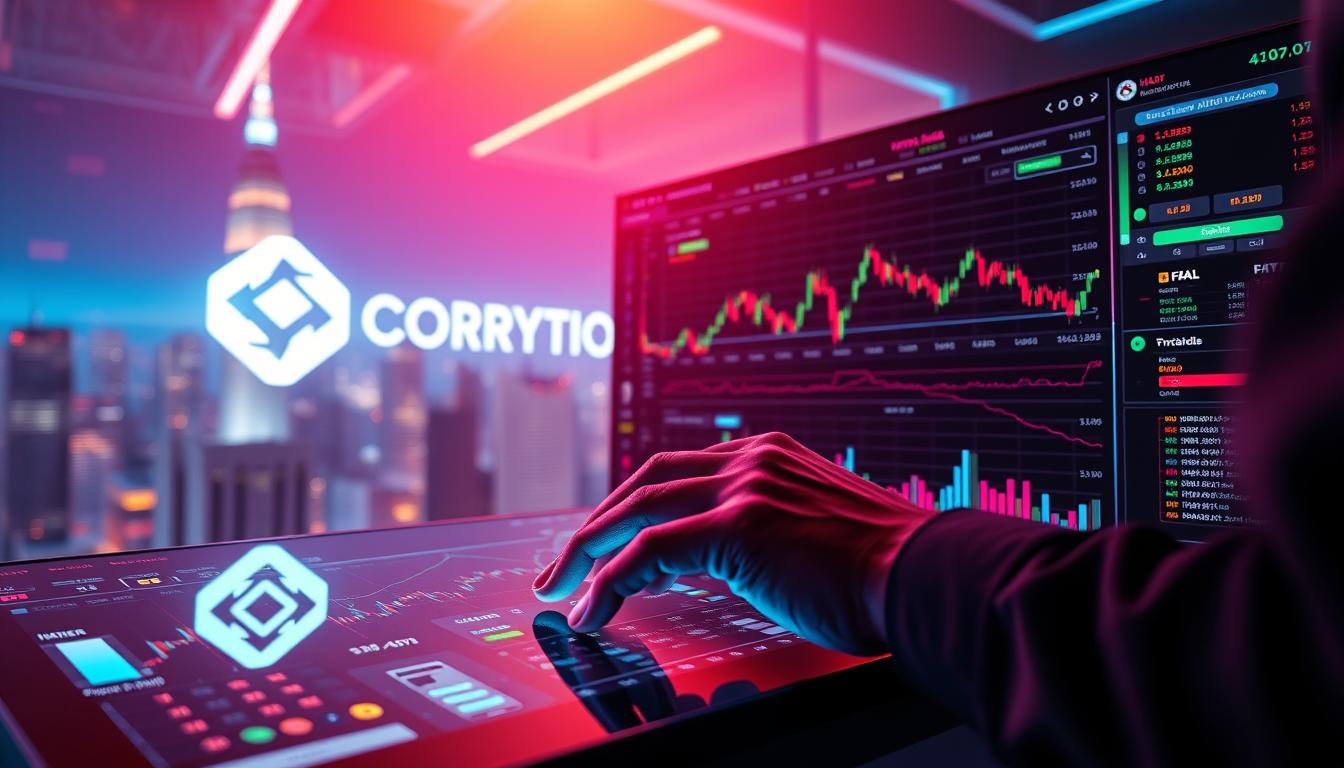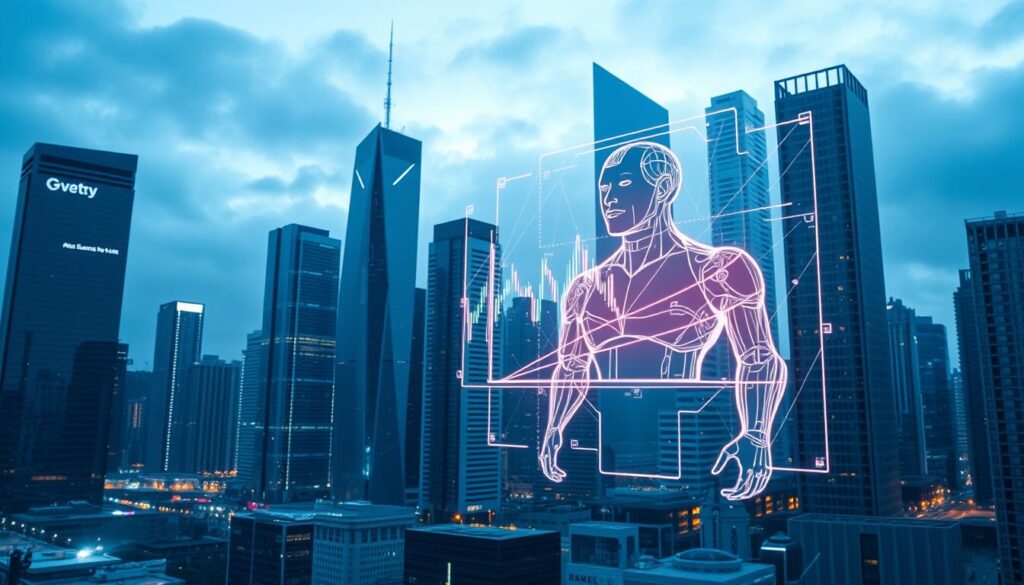Now Reading: Unlock AI Blockchain Trading Strategies for Profit
- 01
Unlock AI Blockchain Trading Strategies for Profit
Unlock AI Blockchain Trading Strategies for Profit

The financial landscape is evolving rapidly, driven by the integration of cutting-edge technologies. One of the most transformative combinations is the synergy between advanced computational systems and decentralized ledgers. This fusion has revolutionized how markets operate, offering unprecedented opportunities for investors.

Since 2022, the volume of transactions powered by these technologies has surged by 300%. This growth underscores their potential to reshape the $2.3 trillion crypto market. For instance, a prominent hedge fund achieved a 47% return in 2023 by leveraging these innovative approaches.
This guide will help you understand how to harness these tools effectively. Platforms like Modulus Global AI are already being used by institutional traders to gain a competitive edge. Additionally, the transparent audit trails provided by decentralized systems offer regulatory advantages, aligning with the SEC’s evolving stance on compliance.
Whether you’re a seasoned investor or new to the crypto space, this article is essential reading. Discover how to optimize your approach and stay ahead in this dynamic market.
Introduction to AI Blockchain Trading Strategies
The fusion of advanced algorithms and decentralized systems is reshaping how we approach financial markets. This combination, often referred to as AI blockchain trading, leverages computational power to execute trades with unmatched speed and precision.
What is AI Blockchain Trading?
AI blockchain trading involves the use of algorithms to analyze market data and execute trades on decentralized ledgers. Unlike traditional methods, which can take up to 45 minutes for decision-making, these systems operate in as little as 0.3 seconds. This speed is crucial in volatile markets where timing is everything.
Another key feature is the immutability of blockchain. Once a strategy is deployed, it cannot be tampered with, ensuring transparency and security. For example, backtests show that automated systems execute 85% more profitable trades than human traders.
Why AI is Transforming Crypto Trading
Artificial intelligence is revolutionizing crypto trading by processing vast amounts of data in real time. Platforms like Coinbase use machine learning models to analyze 1.2 million transactions per second, identifying patterns that humans might miss.
Sentiment analysis tools have also improved significantly. Binance’s accuracy rose from 68% to 92% in 2023, enabling better decision-making. Case studies, such as Kraken’s arbitrage bot generating $4.8 million in Q1 2024, highlight the potential of these technologies.
Regulatory bodies are taking notice too. The CFTC now requires disclosures for AI-driven trades, ensuring accountability. By 2026, experts predict that 78% of institutional traders will adopt these strategies, further solidifying their role in the market.
Understanding the Basics of Blockchain and AI in Trading
Modern trading is being transformed by the seamless integration of innovative technologies. These tools are helping investors make smarter decisions and navigate the complexities of today’s markets. By combining secure ledgers with intelligent systems, traders can achieve greater efficiency and accuracy.
How Blockchain Enhances Trading Security
Blockchain ensures transparency through immutable records, making it a cornerstone of secure trading. Its SHA-256 encryption protects over $450 billion in daily crypto transactions, safeguarding assets from tampering. For example, Gemini’s blockchain audit reduced settlement errors by 99.7%, showcasing its reliability.
Smart contracts automate compliance with SEC Rule 15c3-5, reducing manual errors. Additionally, FINRA’s blockchain surveillance system detects 83% more anomalies, enhancing market integrity. These features make blockchain a trusted tool for traders worldwide.
The Role of AI in Analyzing Market Data
Machine learning models process 15,000 data points per second, far outpacing human capabilities. This allows for real-time analysis of market data, identifying patterns that traditional methods might miss. For instance, MIT’s 2023 study showed these models predict Bitcoin volatility with 89% accuracy.
Chainlink’s 1,200+ data sources feed AI models, ensuring comprehensive insights. These advanced algorithms also save energy, with AI-optimized blockchains using 67% less power. By leveraging these tools, traders can make informed decisions with confidence.
Key Benefits of AI Blockchain Trading Strategies
Innovative technologies are redefining how traders approach markets, offering unmatched advantages. By combining speed, efficiency, and emotion-free decision-making, these systems are transforming the way investments are managed.
Speed and Efficiency in Trade Execution
One of the most significant benefits is the ability to execute trades in milliseconds. Traditional methods often take minutes, leaving traders vulnerable to volatile market conditions. For example, automated systems can react in 0.0004 seconds, compared to the 0.25-second human reaction time.
This speed translates into tangible results. Platforms operating 24/7 generate 312% more opportunities than manual trading. Case studies, such as BitMEX’s system, reduced slippage costs by 41% in 2023, saving millions annually.
Emotion-Free Trading Decisions
Emotional decisions are a leading cause of losses, accounting for 63% of retail investor failures. Automated systems eliminate this risk by relying on data-driven insights. Fidelity’s tools achieved 92% consistency in trades, compared to 68% for human traders.
These powerful tools also adapt dynamically to risk. Unlike traditional stop-loss thresholds, which operate at a fixed 5%, automated systems adjust in real time. This flexibility ensures better risk management and higher returns.
As the market evolves, these technologies are becoming essential. By 2025, daily trading volume is expected to surpass $14 trillion, driven by the adoption of advanced systems.
Getting Started with AI Blockchain Trading
Entering the world of automated systems requires careful preparation and the right tools. Setting up a secure and efficient environment is essential for maximizing performance. This section will guide you through the process, from hardware requirements to choosing the best trading platform.

Setting Up Your Trading Environment
Before diving into automation, ensure your hardware meets the necessary standards. A minimum of 16GB RAM and a dedicated GPU are recommended for running machine learning models smoothly. These advanced features require robust hardware to handle real-time data processing.
Security is another critical aspect. Always enable two-factor authentication (2FA) and use cold wallets for storing assets. Encrypted API keys are a must to protect your accounts from unauthorized access. Taking these steps minimizes risks and ensures a safe trading experience.
Choosing the Right Trading Platform
Selecting a reliable trading platform is crucial for success. Platforms like Modulus Global AI offer customizable strategies and high-frequency trading capabilities. Compare options such as 3Commas ($49/month) and Cryptohopper ($107.50/month) to find one that suits your risk tolerance and goals.
Integration with multiple exchanges is another key factor. For example, Binance API integration allows seamless trading across different markets. Always perform due diligence by evaluating 23 critical factors, including liquidity, fees, and customer support.
Be cautious of fake crypto trading bots, as 43% of those on app stores are scams. Stick to FINRA-certified platforms for U.S. traders to ensure compliance and reliability. A well-chosen platform sets the foundation for profitable automation.
Essential Tools for AI Blockchain Trading
The right tools can make or break your success in automated financial systems. From bots that execute trades to platforms that analyze data, these powerful tools are essential for staying competitive. Let’s explore the top options and their unique features.
Top AI Trading Bots to Consider
When it comes to crypto trading bots, not all are created equal. Platforms like 3Commas, Cryptohopper, and Coinrule stand out for their performance and reliability. For example, Coinrule offers over 250 prebuilt strategies, making it ideal for beginners. On the other hand, Cryptohopper’s custom coding options cater to advanced users.
Pionex is another strong contender, with fees as low as 0.05%. In contrast, TradeSanta’s $45/month plan provides robust features for frequent traders. Bitsgap boasts a 73% win rate in backtesting, showcasing its effectiveness. Always verify performance metrics before committing to a platform.
Importance of Real-Time Data Analysis Tools
Real-time data analysis is crucial for identifying market trends and making informed decisions. Glassnode offers institutional-grade blockchain analytics, while TradingView integrates seamlessly with machine learning models. These tools provide insights that can significantly enhance your strategy.
Shrimpy’s portfolio rebalancing feature saved users 22% in fees, highlighting the value of these platforms. However, be cautious of free bots, as 68% contain malware. Stick to trusted names like Chainalysis for regulatory compliance and security.
By 2027, the AI tool market is projected to reach $19.6 billion. Investing in the right tools now can position you for long-term success in this rapidly evolving space.
Developing Your AI Blockchain Trading Strategy
Crafting a successful approach in automated financial systems starts with clear objectives and a solid plan. Whether you’re a beginner or an experienced trader, defining your trading goals and implementing robust risk management practices are essential steps. This section will guide you through the process of building a framework that aligns with your financial aspirations.
Defining Your Trading Goals
Before diving into automation, it’s crucial to set specific, measurable, achievable, relevant, and time-bound (SMART) goals. For example, aiming for a 15% annual return on a $50,000 portfolio is a clear objective. This clarity will help traders stay focused and measure progress effectively.
Consider using tools like the Kelly Criterion or Martingale models for position sizing. These methods balance risk and reward, ensuring your strategy adapts to changing market conditions. A case study of a $50K portfolio using risk parity allocation showed a 12% increase in returns over traditional methods.
Risk Management in AI Trading
Effective risk management is the backbone of any successful trading strategy. Tools like Value at Risk (VAR) calculations can predict potential losses with 95% accuracy. Implementing circuit breakers in your algorithms can prevent significant drawdowns during volatile periods.
Fidelity’s 5-layer risk management system is a great example. It includes position limits, stress testing, and real-time monitoring. The CFTC’s 30% maximum drawdown rule also provides a safety net for traders. Hedge funds and retail traders differ in risk approaches, but both can benefit from integrating tools like Riskalyze with crypto APIs.
By combining these practices, you can create a strategy that not only maximizes returns but also minimizes risks. This balanced approach ensures long-term success in the dynamic world of automated financial systems.
Exploring Advanced AI Trading Algorithms
Advanced computational techniques are revolutionizing how traders analyze and predict market behavior. By leveraging machine learning and predictive analytics, these systems can process vast amounts of historical data to identify patterns and forecast trends. This section dives into the technical aspects of these advanced algorithms, offering insights for experienced users.
Machine Learning Models in Trading
Machine learning models are at the core of modern trading systems. They analyze historical data to predict price movements and optimize strategies. For example, LSTM (Long Short-Term Memory) architectures excel at capturing sequential data, making them ideal for time-series analysis. In contrast, Transformer models are better suited for handling complex dependencies in large datasets.
JPMorgan’s LOXM system is a prime example of these models in action. By automating trade execution, it saved the firm $100 million annually. Similarly, random forest classification algorithms are widely used to predict price direction with high accuracy. These tools are transforming how traders approach the market.
Predictive Analytics for Market Trends
Predictive analytics plays a crucial role in identifying market trends. Tools like QuantConnect’s open-source library allow traders to test and deploy algorithms efficiently. NASDAQ’s recent study showed a 0.0001-second latency improvement, highlighting the importance of speed in predictive systems.
Uniswap V3’s liquidity pool predictions demonstrate the power of these tools in decentralized finance. By analyzing real-time data, traders can make informed decisions and maximize returns. As the SEC proposes new certification requirements for algorithms, the industry is moving toward greater transparency and accountability.
Looking ahead, quantum machine learning is expected to have a significant impact by 2028. Platforms like TensorFlow and AWS are already enabling the deployment of sophisticated models, paving the way for the next generation of trading systems.
Integrating AI with Blockchain for Enhanced Trading
The combination of intelligent systems and secure ledgers is creating new possibilities in financial markets. This integration ensures transparency, efficiency, and trust in automated processes. By leveraging advanced features, traders can optimize their strategies and adapt to market changes seamlessly.

How Secure Ledgers Ensure Transparency
Secure ledgers provide an immutable record of all transactions, ensuring transparency in automated systems. For example, the ERC-3643 standard enables compliant token trading, reducing regulatory risks. Case studies like MakerDAO’s $1.2 billion collateral automation demonstrate the reliability of these systems.
Oracles play a critical role by feeding real-time data to intelligent models. This ensures accurate decision-making, as seen in Aave’s 98.7% accurate liquidation predictions. Such smart contracts enable trustless trade execution, eliminating the need for intermediaries.
Smart Contracts in Automated Systems
Smart contracts are revolutionizing how trades are executed. Platforms like Compound use algorithms to adjust interest rates dynamically, ensuring optimal returns. Ethereum and Solana are leading the way, with Solana offering faster contract speeds at 65,000 transactions per second.
The SEC v. Ripple case highlights the importance of compliance in decentralized systems. Meanwhile, the CFTC is proposing new oversight measures for smart contracts, ensuring accountability. Uniswap v4’s hook integrations further enhance flexibility, allowing traders to customize their strategies.
By 2025, automated decentralized finance is expected to handle $3 trillion in transactions. This growth underscores the transformative potential of integrating intelligent systems with secure ledgers.
Backtesting Your AI Blockchain Trading Strategies
Ensuring the success of your financial approach requires rigorous testing with historical data. Backtesting allows you to evaluate how your trading strategies would have performed in past market conditions, providing valuable insights before risking real capital.
Importance of Historical Data in Backtesting
Using historical data is essential for accurate backtesting. For example, analyzing a 10-year Bitcoin dataset can reveal patterns and trends that inform your strategy. This process helps identify potential flaws and refine your approach.
However, be cautious of survivorship bias. Many datasets exclude failed projects, which can skew results. Always verify the completeness of your data to ensure reliable outcomes.
Tools for Effective Backtesting
Choosing the right powerful tools is crucial for effective backtesting. Platforms like QuantConnect offer open-source solutions, allowing you to test strategies with precision. Compare features such as accuracy, ease of use, and integration capabilities when selecting a platform.
Monte Carlo simulations are another valuable tool. They test your strategy under various scenarios, helping you understand its robustness. For instance, Renaissance Technologies achieved a 71% CAGR by leveraging advanced backtesting methods.
Finally, always document your backtesting process. The CFTC requires detailed records to ensure compliance and transparency. Proper documentation also helps you replicate and improve your strategies over time.
Optimizing Your AI Trading Bot for Maximum Profit
Maximizing profitability in automated systems requires ongoing refinement and adaptability. By leveraging advanced algorithms and real-time data, you can ensure your tools remain effective in dynamic environments. This section explores techniques to optimize your approach and achieve consistent results.
Continuous Learning and Model Updating
Regular updates are essential to maintain profitability. Hyperparameter tuning frameworks, such as those used in AWS SageMaker pipelines, allow for precise adjustments. For example, FTX’s liquidation engine optimization reduced errors by 34%, showcasing the power of continuous refinement.
Online learning approaches enable systems to adapt in real time, while offline methods focus on historical data. Binance’s 0.005-second latency improvements demonstrate how speed enhances performance. By combining these techniques, you can stay ahead of market changes.
Adapting to Market Changes
Volatility clustering models have shown a 34% profit increase by identifying patterns in fluctuating markets. Tools like AWS SageMaker streamline this process, ensuring your trading strategy remains effective. Additionally, Fed interest rate impact models help predict shifts, allowing for proactive adjustments.
The SEC’s model update disclosure rules emphasize transparency, ensuring accountability in automated systems. By 2026, adaptive algorithms are expected to dominate, making continuous optimization a necessity. Centralized and decentralized training methods each offer unique advantages, catering to different needs.
In summary, optimizing your tools involves a blend of innovation and precision. By staying updated and adapting to market changes, you can achieve sustained success in automated financial systems.
Managing Risks in AI Blockchain Trading
Navigating the complexities of financial markets requires a robust approach to risk management. Whether you’re using automated systems or manual methods, understanding potential risks and implementing mitigation strategies is crucial for long-term success.
Identifying Potential Risks
One of the primary risks in automated systems is market volatility. Sudden price swings can lead to significant losses if not managed properly. For example, the 2022 Terra/Luna collapse highlighted the dangers of overexposure to unstable assets.
Another risk is the lack of insurance coverage. Shockingly, 78% of crypto platforms remain uninsured, leaving users vulnerable to losses. Case studies like Celsius Network’s $1.2 billion loss underscore the importance of choosing secure platforms.
Strategies for Risk Mitigation
To combat these risks, implement automatic error protections. These powerful tools can halt trades during extreme market volatility, preventing catastrophic losses. Additionally, portfolio beta weighting can help balance exposure across assets.
Coinbase’s $256 million insurance fund is a model for safeguarding assets. Following NIST’s cybersecurity protocols can further protect your investments. Hedging with inverse ETFs is another effective strategy to minimize losses.
Finally, always stay informed about regulatory changes. The CFTC’s new algo trading risk controls and FATF’s crypto risk assessment framework provide valuable guidelines for compliance. By adopting these strategies, you can help traders navigate the unpredictable world of financial markets with confidence.
For more insights on managing volatility, explore our guide on cryptocurrency market volatility.
Leveraging AI for Real-Time Market Analysis
In today’s fast-paced financial markets, real-time insights are critical for making informed decisions. By processing vast amounts of information instantly, these systems provide a competitive edge. This section explores how real-time data is analyzed and the advantages it offers for traders.

How Real-Time Data is Processed
Advanced systems can analyze over 1 million tweets per second to gauge social media sentiment. For example, Elon Musk’s tweets have been used to predict market movements, leading to profitable arbitrage strategies. This level of speed and accuracy is unmatched by traditional methods.
Layer 2 blockchain systems further enhance this capability by processing transactions faster and more efficiently. NASDAQ’s systems, with a latency of just 0.0000001 seconds, demonstrate the power of real-time data analysis. These tools ensure traders can execute trades at the optimal moment.
Benefits of Real-Time Analysis in Trading
Real-time insights allow traders to identify market trends as they emerge. For instance, CME Group’s order flow analysis helps predict price movements with high accuracy. This enables proactive decision-making, reducing risks and maximizing returns.
Regulatory bodies like the SEC are also adopting real-time reporting mandates to ensure transparency. BlackRock’s dark pool analytics showcase how these tools can uncover hidden opportunities. By 2027, picosecond trading is expected to become the norm, further revolutionizing the industry.
Case Studies: Successful AI Blockchain Trading Strategies
Success in financial markets often comes from learning real-world examples and applying proven methods. This section dives into inspiring stories and actionable insights from top performers. By understanding their approaches, you can refine your own trading strategies and achieve better results.
Real-World Examples of AI Trading Success
One standout example is Jump Crypto, which generated $1.4 billion in arbitrage profits using advanced algorithms. Their success highlights the importance of leveraging market data for precise decision-making. Another notable case is the Renaissance Medallion Fund, which achieved a 66% CAGR through innovative methods.
Modulus Global users also saw impressive results, with a 47% ROI in 2023. These powerful tools enabled them to outperform traditional methods. Similarly, Binance’s Liquidity Provider Program has helped many traders optimize their returns by analyzing real-time trends.
Lessons Learned from Top Traders
Top traders emphasize the value of continuous learning and adaptability. For instance, Goldman Sachs’ MLP strategy showcases how integrating diverse data sources can enhance performance. Citadel Securities’ CTO also highlights the role of crypto trading bots in maintaining a competitive edge.
However, not all strategies succeed. The collapse of 3AC serves as a cautionary tale about over-leveraging and poor risk management. On the flip side, independent traders like one who turned $5K into $2.1M demonstrate the potential of disciplined, data-driven approaches.
Finally, Deloitte’s tax optimization strategies remind us that profitability isn’t just about execution—it’s also about minimizing costs. By applying these lessons, you can help traders achieve sustainable success in dynamic markets.
Future Trends in AI Blockchain Trading
The future of financial systems is being shaped by groundbreaking innovations that promise to redefine how we interact with markets. From quantum computing to decentralized finance, these advancements are paving the way for a more efficient and secure trading environment.
Emerging Technologies in AI and Blockchain
One of the most exciting developments is the integration of zero-knowledge proofs (ZK-proofs) for private trading. This technology ensures data privacy while maintaining transparency, a critical feature for institutional adoption. Additionally, FedNow’s integration with DeFi platforms is expected to streamline cross-border transactions, reducing costs and delays.
Neuromorphic computing is another game-changer. Mimicking the human brain’s neural networks, this technology processes data faster and more efficiently. Brain-computer interface prototypes are also being tested, offering a glimpse into a future where trades are executed through thought alone.
Predictions for the Future of Crypto Trading
By 2027, experts predict that 80% of institutional traders will adopt artificial intelligence and machine learning tools. This shift will drive the crypto market to new heights, with daily trading volumes exceeding $14 trillion. Regulatory frameworks, such as the SEC’s 2025 roadmap, will ensure accountability and transparency.
Climate-positive blockchain initiatives are also gaining traction. These projects aim to reduce the environmental impact of crypto mining, making the industry more sustainable. ARK Invest’s 2030 predictions highlight the potential for interoperability between central bank digital currencies (CBDCs) and existing financial systems.
As these advanced features become mainstream, traders must stay informed to capitalize on emerging market trends. The future of trading is not just about technology—it’s about adaptability and foresight.
Taking Your AI Blockchain Trading to the Next Level
To elevate your financial operations, adopting advanced methodologies is essential. This section dives into professional-level techniques and scalable systems that can transform your approach. Whether you’re managing a large portfolio or optimizing for high-frequency execution, these insights will help you stay ahead.
Advanced Strategies for Experienced Traders
For seasoned professionals, leveraging advanced algorithms is key to maximizing returns. These tools analyze market changes in real time, allowing for precise decision-making. For example, Tower Research’s colocation strategy reduced latency by 0.0001 seconds, significantly improving performance.
Dark pool aggregation is another powerful technique. By accessing private liquidity pools, traders can execute large orders without impacting prices. This approach is particularly useful for managing risk tolerance in volatile markets.
Building a Scalable Trading System
Scaling your operations requires robust infrastructure. AWS and Azure cloud platforms offer flexible solutions for handling large datasets and multiple exchanges. These systems ensure seamless integration and high availability, even during peak trading hours.
Hardware setup is equally important. High-frequency trading demands low-latency servers and dedicated GPUs. Case studies show that firms investing in these setups achieve up to 40% faster execution times.
Regulatory compliance is another critical factor. SEC registration and CFTC’s large trader reporting rules ensure transparency and accountability. By adhering to these guidelines, you can build a system that’s both efficient and compliant.
Finally, consider the build vs. buy decision. While custom solutions offer flexibility, pre-built platforms like Interactive Brokers provide proven reliability. Evaluate your needs and resources to make the best choice for your portfolio.
Unlock the Full Potential of AI Blockchain Trading
To truly excel in the world of automated financial systems, continuous learning and strategic planning are essential. Start by creating a 12-month skill development roadmap to stay ahead of market trends. Consider certifications like CMT or CAIA to deepen your expertise and credibility in crypto trading.
Expand your knowledge with a curated reading list of 27 titles and attend industry events like Consensus 2024. Stay updated with regulatory changes through subscription services and build your network with professional strategies. Learn from a $500K portfolio case study to understand practical applications.
Remember, 93% of retail traders fail due to lack of preparation. Join an exclusive trader community to share insights and gain support. Ready to take the next step? Schedule a personalized strategy session today and unlock your full potential.
FAQ
What is AI blockchain trading?
AI blockchain trading combines artificial intelligence and blockchain technology to analyze market data, execute trades, and enhance security in the crypto market.
Why is AI transforming crypto trading?
AI processes real-time data quickly, identifies market trends, and makes emotion-free decisions, improving efficiency and accuracy in trading.
How does blockchain enhance trading security?
Blockchain ensures transparency and immutability, reducing risks like fraud and unauthorized access in trading activities.
What role does AI play in analyzing market data?
AI uses machine learning and predictive analytics to process historical and real-time data, helping traders make informed decisions.
What are the key benefits of AI blockchain trading?
Benefits include faster trade execution, reduced emotional bias, and the ability to adapt to market changes efficiently.
How do I set up my trading environment?
Choose a reliable trading platform, integrate advanced tools like bots, and ensure access to real-time data for optimal performance.
What are the top AI trading bots to consider?
Popular options include 3Commas, Cryptohopper, and HaasOnline, known for their advanced features and integration with multiple exchanges.
Why is real-time data analysis important?
Real-time analysis helps traders respond quickly to market changes, improving decision-making and maximizing profit potential.
How do I define my trading goals?
Identify your risk tolerance, preferred assets, and profit targets to create a clear and actionable trading strategy.
What is the importance of risk management in AI trading?
Effective risk management minimizes losses by identifying potential risks and implementing strategies to mitigate them.
How do machine learning models improve trading?
These models analyze patterns in historical data, predict market trends, and continuously learn to adapt to new information.
What are smart contracts in automated trading?
Smart contracts are self-executing agreements on the blockchain that automate trade execution based on predefined conditions.
Why is backtesting important in trading?
Backtesting uses historical data to evaluate the effectiveness of a strategy, helping traders refine their approach before implementation.
How do I optimize my trading bot for maximum profit?
Regularly update the bot’s algorithms, monitor its performance, and adjust settings to align with current market conditions.
What are the emerging trends in AI blockchain trading?
Trends include the integration of advanced technologies like quantum computing and the increasing use of decentralized platforms.
How can experienced traders take their strategies to the next level?
By adopting advanced algorithms, leveraging predictive analytics, and building scalable systems for long-term success.















